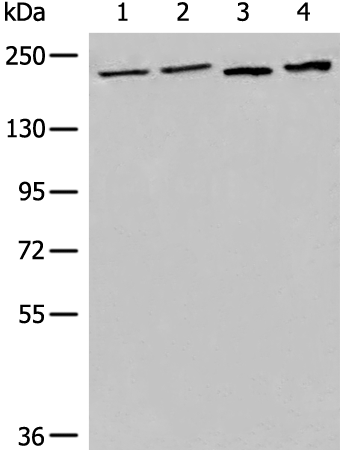
| WB | 咨询技术 | Human,Mouse,Rat |
| IF | 咨询技术 | Human,Mouse,Rat |
| IHC | 咨询技术 | Human,Mouse,Rat |
| ICC | 技术咨询 | Human,Mouse,Rat |
| FCM | 咨询技术 | Human,Mouse,Rat |
| Elisa | 1/5000-1/10000 | Human,Mouse,Rat |
| Aliases | MST105; ZFYVE2; MSTP105 |
| WB Predicted band size | 163 kDa |
| Host/Isotype | Rabbit IgG |
| Antibody Type | Primary antibody |
| Storage | Store at 4°C short term. Aliquot and store at -20°C long term. Avoid freeze/thaw cycles. |
| Species Reactivity | Human, Mouse |
| Immunogen | Synthetic peptide of human EEA1 |
| Formulation | Purified antibody in PBS with 0.05% sodium azide and 50% glycerol. |
+ +
以下是关于EEA1抗体的3篇经典文献及其摘要:
---
1. **文献名称**: *EEA1 Links PI(3)K Function to Rab5 Regulation of Endosome Fusion*
**作者**: Simonsen, A. et al.
**摘要**: 该研究揭示了EEA1通过其FYVE结构域结合磷脂酰肌醇-3-磷酸(PI3P),并作为Rab5效应蛋白协调早期内体的膜融合过程,为内体运输机制提供了关键分子机制。
2. **文献名称**: *Molecular Characterization of EEA1: A Protein Involved in Endosomal Vesicle Fusion*
**作者**: Mu, F.T. et al.
**摘要**: 首次克隆并鉴定了EEA1的分子结构,证明其通过C端FYVE结构域定位至早期内体,并参与调控内体囊泡的融合,为后续研究EEA1功能奠定了基础。
3. **文献名称**: *EEA1 Binding to Phosphoinositides Regulates Endosome Membrane Dynamics*
**作者**: Christoforidis, S. et al.
**摘要**: 研究发现EEA1依赖PI3P和Rab5-GTP的协同作用锚定至内体膜,其磷酸肌醇结合能力对维持内体形态和货物分选至关重要,揭示了脂质-蛋白互作在内体功能中的核心作用。
---
这些文献涵盖了EEA1的结构、功能及其在细胞内运输中的调控机制,适用于抗体应用(如定位、功能抑制等)的理论参考。如需具体实验应用文献,可进一步补充。
The Early Endosome Antigen 1 (EEA1) antibody is a widely used tool in cell biology to study endosomal trafficking and membrane dynamics. EEA1 is a peripheral membrane protein localized to early endosomes, where it plays a critical role in endosome maturation, fusion, and cargo sorting. The protein contains an N-terminal Rab5-binding domain, a central coiled-coil region, and a C-terminal FYVE domain that binds phosphatidylinositol-3-phosphate (PI3P), anchoring it to early endosomal membranes.
EEA1 antibodies are primarily employed as markers for early endosomes in immunofluorescence, immunoelectron microscopy, and Western blotting. They help visualize the spatial organization of endosomes and track vesicular transport pathways in cellular processes like receptor internalization, autophagy, and pathogen entry. Dysregulation of EEA1-associated pathways has been linked to diseases, including cancer and neurodegenerative disorders, making these antibodies valuable in both basic research and translational studies.
Commercially available EEA1 antibodies are typically raised in rabbits or mice against specific epitopes, such as the C-terminal region. Validation includes testing for colocalization with Rab5 or other early endosome markers. Researchers must optimize protocols to avoid cross-reactivity with structurally similar proteins (e.g., Hrs or SARA) and ensure species compatibility. Overall, EEA1 antibodies remain indispensable for investigating intracellular trafficking mechanisms and their physiological or pathological implications.
×